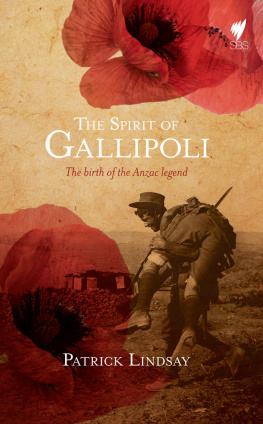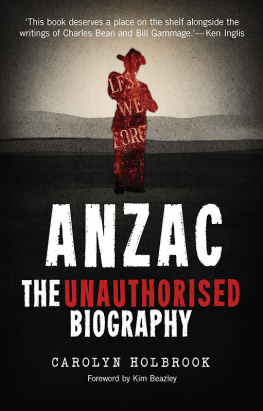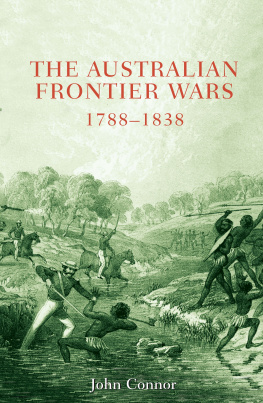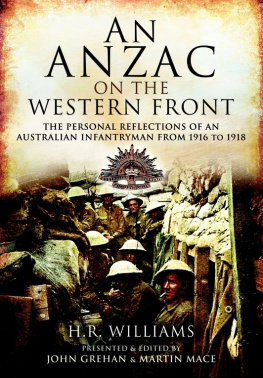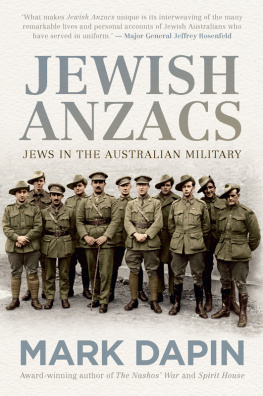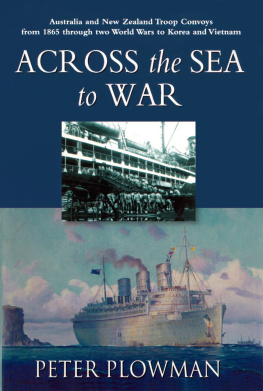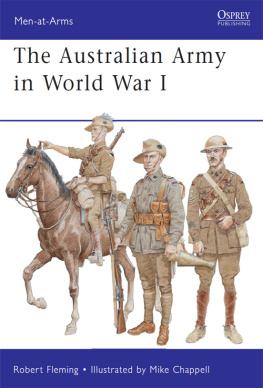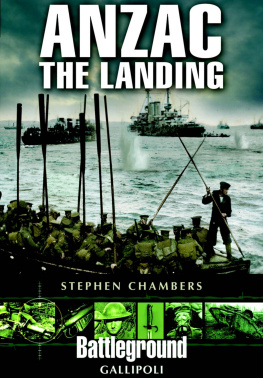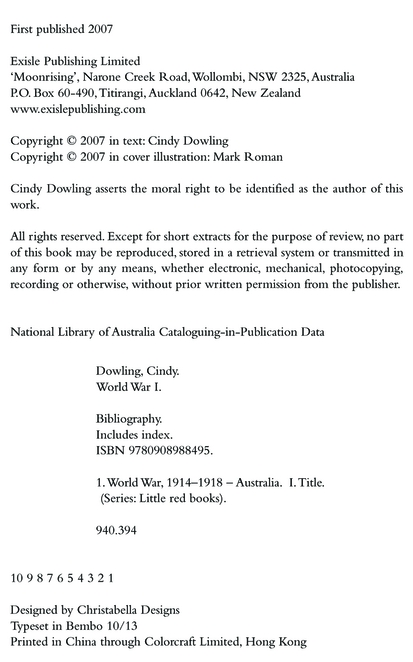Chapter 1
THE OUTBREAK OF WAR
It is unthinkable to believe that because an archuke [sic] and his missus were slain by a fanatic the whole of Europe should become a seething battlefield and deplorable misery brought upon the people. What glory is there in todays warfare? None whatever; it is only slaughter and carnage.editorial from the Melbourne Labor Call, 3 August 1914
The day of 28 June 1914 was to be an exciting one for the Duchess of Hohenburg. Not only was it her fourteenth wedding anniversarya day which celebrated a remarkably happy union with Archduke Franz Ferdinand, heir to the Hapsburg thronebut she was to enjoy the unusual honour of being allowed to sit beside her husband as his motorcade drove through the Bosnian city of Sarajevo during a visit to the region.
In class-conscious Vienna, the duchesss lack of royal pedigree meant that such a simple courtesy was out of the question, and she was usually required to travel in a separate vehicle while her husband performed his official duties. But here, on a scorching summers day in the Balkansan area regarded as something of a backwater by the Hapsburg regime the restrictions of Austrian high society must have seemed a distant memory, and the couple decided to throw royal protocol to the wind, if only for a short time.
It was a trip that would prove fatal for them both and catastrophic for the rest of the world, including Australia.
For all its provincial charms, Serbia was in fact a dangerously divided corner of an increasingly unhappy empire. Acquired haphazardly over centuries through war and marriage, the Austro-Hungarian regime contained eleven different ethnic groups, some of whomincluding Bosnian Serbswere demanding greater autonomy. The Bosnian Serbs were also disgruntled by concerns that Austria-Hungary was considering giving Bosnia and Herzegovina to Croatia rather than to Serbia.
The Black Hand was one of a number of illegal nationalist organisations operating in the region at the time of the archdukes visit. But unlike most groups of its kind, the Black Hand had friends in high places. One of its founders, Colonel Dragutin Dimitrijevic, was chief of intelligence in the Serbian General Staff, and others amongst its 2500-strong membership included lawyers and army officers.
With a charter that demanded the unification of Serbia and the use of violence to achieve those ends, the Black Hand had already made one failed attempt to assassinate the head of the Hapsburgs, Emperor Franz Josef, the archdukes father. The visit to Sarajevo by the next in line to the throne was seen as an opportunity to make amends for their earlier failure and afforded a chance to force Vienna into allowing the formation of an independent Greater Serbia.
At around 10am a four-car motorcade, which included the archduke and his wife Sophie in the second car, set off for the city hall, where the archduke was to give a speech. Waiting en route were seven Black Hand assassins. Near the Cumuria Bridge, two of the Black Hand brigade threw a bomb towards the royal car. It was deflected by the archduke, although not before slightly wounding his wife in the face as well as several others from the motorcade and in the crowd.
Incredibly, despite the attack and the arrest of one of the assassins (who had tried to commit suicide by swallowing cyanide and jumping in the Milijacka River, only to discover the cyanide was past its use-by date and the river was only a few centimetres deep), the archduke opted to continue on to the city hall, where he allegedly chastised Sarajevos mayor by saying, One comes here to visit and is received with bombs. After accepting the mayors apologies, he then declared he wanted to be taken to the hospital to visit the other bomb victims.
What followed might almost be comical were it not for its ultimately tragic outcome.
As the archdukes car headed for the hospital, Gavrilo Princip, one of the conspirators, was entering a food shop, most likely having decided that the assassination attempt had failed. As he emerged from the shop, he saw Franz Ferdinands car reversing in the street outsidethe driver had not been informed of the change of plan and had been heading out of the city rather than towards the hospital. Seizing what must have seemed a remarkably unlikely opportunity, Princip pulled out his gun and fired twice into the car. The first bullet struck Sophie, the duchess, in the stomach; the second hit her husband in the neck.
The history website offers this recollection from Count Franz von Harrach, a bodyguard who was riding on the running board of the vehicle at the time:
As the car quickly reversed, a thin stream of blood spurted from His Highness mouth onto my right cheek. As I was pulling out my handkerchief to wipe the blood away from his mouth, the Duchess cried out to him, In Heavens name, what has happened to you? At that she slid off the seat and lay on the floor of the car, with her face between his knees. I had no idea that she too was hit and thought she had simply fainted with fright. Then I heard His Imperial Highness say, Sopheri, Sopheri, dont die. Stay alive for the children!Both the archduke and Sophie died whilst being driven to medical treatment. That evening, anti-Serbian riots broke out in Sarajevoa small taste of the turmoil that was to come.
Why did the war begin?
Why the murder of a single, rather unremarkable future head of statein a place that most would have been hard-pressed to locate on a mapshould lead to thousands of Australians being sent to fight and die on foreign battlefields, is a complex question. At its heart lies both the desire of the Austro-Hungarian empire to protect its authority from being eroded by unrest and a convoluted knot of pacts, treaties and ancient suspicions between other European nations.
The concept of sovereign nation-states, often referred to as the Westphalia system, had only begun to take root in Europe in the mid seventeenth century. With the idea of nationhood came social upheaval and challenges to the existing balances of power within empires. The unification of Italy in 1866 and of Germany in 1871, after long and often bloody outbreaks of warfare, radically altered the power map of Europe. The decision in 1867 for the former Austrian empire to become a dual monarchy, in an effort to stem emergent nationalism and retain the power of the German aristocracy, created wide-reaching tensions and jealousies, both within the region itself and further afield.
At the same time, the lure of colonialism and the rise of the social Darwinism conceptthe idea that life was a competition between different nations, ethnic and racial groups, and that only the fittest could and would survive in the long termensured that being more powerful than ones neighbour assumed top priority for most countries.
The assassination in Sarajevo could have remained a localised event, and hostilities limited to Austria-Hungary and Serbia or perhaps even avoided altogether, if certain key players had adopted a more cautious and conciliatory approach. Instead, after procrastinating for three weeks the Austrians decided that the assassination offered the perfect excuse for strong-arm tactics to be employed against the Serbians.
Accusing the Serbian government of direct implication in the arch dukes murdera claim still in dispute amongst historians todaythe Austrians issued an ultimatum to Serbia, demanding that not only must the assassins be brought to justice, but that the Serbs would actively ensure any public expressions of anti Austro-Hungarian nationalism, including in the media, be quashed immediately. They hoped that such a show of force would crush the nationalist movement and ensure a solid Austro-Hungarian presence in the Balkans once more.




